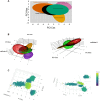Amino acid-specific isotopes reveal changing five-dimensional niche segregation in Pacific seabirds over 50 years
- PMID: 38570566
- PMCID: PMC10991557
- DOI: 10.1038/s41598-024-57339-w
Amino acid-specific isotopes reveal changing five-dimensional niche segregation in Pacific seabirds over 50 years
Abstract
Hutchison's niche theory suggests that coexisting competing species occupy non-overlapping hypervolumes, which are theoretical spaces encompassing more than three dimensions, within an n-dimensional space. The analysis of multiple stable isotopes can be used to test these ideas where each isotope can be considered a dimension of niche space. These hypervolumes may change over time in response to variation in behaviour or habitat, within or among species, consequently changing the niche space itself. Here, we use isotopic values of carbon and nitrogen of ten amino acids, as well as sulphur isotopic values, to produce multi-isotope models to examine niche segregation among an assemblage of five coexisting seabird species (ancient murrelet Synthliboramphus antiquus, double-crested cormorant Phalacrocorax auritus, Leach's storm-petrel Oceanodrama leucorhoa, rhinoceros auklet Cerorhinca monocerata, pelagic cormorant Phalacrocorax pelagicus) that inhabit coastal British Columbia. When only one or two isotope dimensions were considered, the five species overlapped considerably, but segregation increased in more dimensions, but often in complex ways. Thus, each of the five species occupied their own isotopic hypervolume (niche), but that became apparent only when factoring the increased information from sulphur and amino acid specific isotope values, rather than just relying on proxies of δ15N and δ13C alone. For cormorants, there was reduction of niche size for both species consistent with a decline in their dominant prey, Pacific herring Clupea pallasii, from 1970 to 2006. Consistent with niche theory, cormorant species showed segregation across time, with the double-crested demonstrating a marked change in diet in response to prey shifts in a higher dimensional space. In brief, incorporating multiple isotopes (sulfur, PC1 of δ15N [baselines], PC2 of δ15N [trophic position], PC1 and PC2 of δ13C) metrics allowed us to infer changes and differences in food web topology that were not apparent from classic carbon-nitrogen biplots.
© 2024. The Author(s).
Conflict of interest statement
The authors declare no competing interests.
Figures




Similar articles
-
Temporal trends of perfluoroalkyl substances (PFAS) in eggs of coastal and offshore birds: Increasing PFAS levels associated with offshore bird species breeding on the Pacific coast of Canada and wintering near Asia.Environ Toxicol Chem. 2015 Aug;34(8):1799-808. doi: 10.1002/etc.2992. Epub 2015 May 18. Environ Toxicol Chem. 2015. PMID: 25989421
-
Spatial and temporal trends in brominated flame retardants in seabirds from the Pacific coast of Canada.Environ Pollut. 2014 Dec;195:48-55. doi: 10.1016/j.envpol.2014.08.009. Epub 2014 Sep 6. Environ Pollut. 2014. PMID: 25194271
-
Temporal trends (1968-2019) of legacy persistent organic pollutants (POPs) in seabird eggs from the northeast Pacific: Is it finally twilight for old POPs?Sci Total Environ. 2023 Feb 1;858(Pt 3):160084. doi: 10.1016/j.scitotenv.2022.160084. Epub 2022 Nov 8. Sci Total Environ. 2023. PMID: 36368377
-
Studying animal niches using bulk stable isotope ratios: an updated synthesis.Oecologia. 2020 May;193(1):27-51. doi: 10.1007/s00442-020-04654-4. Epub 2020 May 11. Oecologia. 2020. PMID: 32393994 Review.
-
Why aquatic scientists should use sulfur stable isotope ratios (ẟ34S) more often.Chemosphere. 2024 May;355:141816. doi: 10.1016/j.chemosphere.2024.141816. Epub 2024 Mar 29. Chemosphere. 2024. PMID: 38556184 Review.
References
-
- Hutchinson GE. Concluding remarks. Cold Spring Harb. Symp. Quant. Biol. 1957;22:415–427. doi: 10.1101/SQB.1957.022.01.039. - DOI
-
- Duque-Lazo J, Navarro-Cerrillo RM, Ruíz-Gómez FJ. Assessment of the future stability of cork oak (Quercus suber L.) afforestation under climate change scenarios in Southwest Spain. For. Ecol. Manag. 2018;409:444–456. doi: 10.1016/j.foreco.2017.11.042. - DOI
-
- Osorio-Olvera L, et al. ntbox: An r package with graphical user interface for modelling and evaluating multidimensional ecological niches. Methods Ecol. Evol. 2020;11:1199–1206. doi: 10.1111/2041-210X.13452. - DOI
-
- Koch C, et al. Applying n-dimensional hypervolumes for species delimitation: unexpected molecular, morphological, and ecological diversity in the Leaf-Toed Gecko Phyllodactylus reissii Peters, 1862 (Squamata: Phyllodactylidae) from northern Peru. Zootaxa. 2016;4161:41–80. doi: 10.11646/zootaxa.4160.2.2. - DOI - PubMed
MeSH terms
Substances
LinkOut - more resources
Full Text Sources
Research Materials
Miscellaneous

